14 Mistakes You Might Be Making With Tilapia
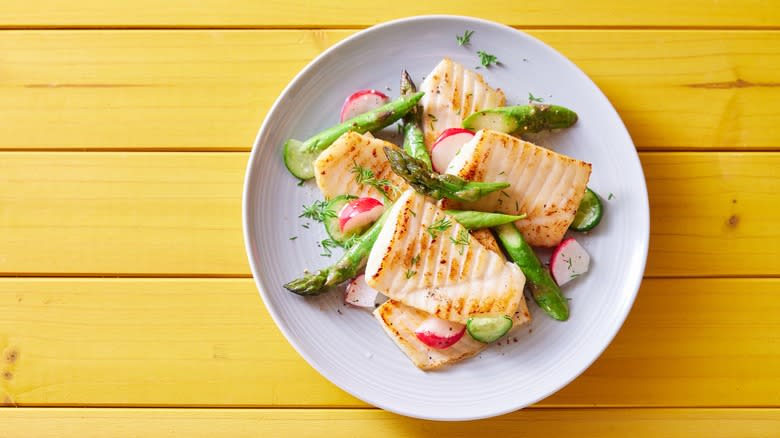
Tilapia is one of the most popular farmed fish species both in the United States and the world and saw a huge boom in its popularity and the demand for it at the end of the 20th and the start of the 21st century. Its appeal is largely down to its affordability and its taste, which is able to slot into a range of recipes with ease. Tilapia has a gently sweet flavor and firm flesh, making it similar to other white fish out there. As such, it has versatility which means that people come back to it time and time again.
But like other white fish, tilapia can also be tricky to prepare and cook. Tilapia's delicate flesh means that it's particularly prone to being overcooked or drying out, and can also mean that it can fall apart or stick easily. As the fish can also be subject to poor farming practices around the world, it can also be challenging to know how to choose it, and which sources to avoid -- even when you're buying it from a reputable buyer, you still need to know which fish is the best quality. Luckily, we're here to make sure you're nailing your tilapia pick every time.
Read more: 12 Underrated Types Of Fish You Should Try At Least Once
Not Buying Fresh Tilapia
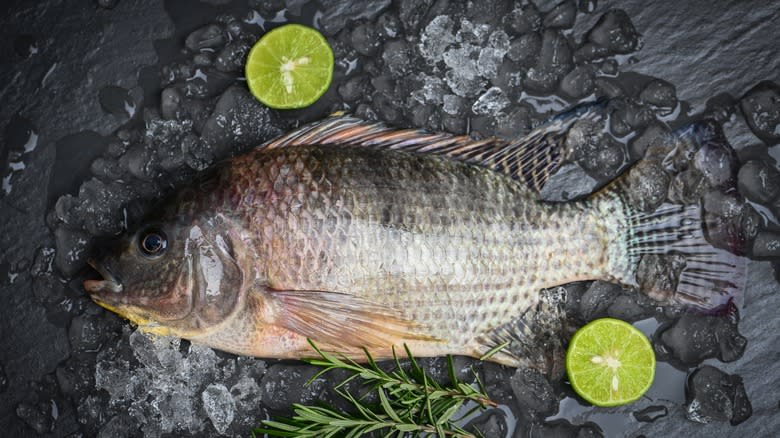
Buying fresh fish can be daunting, but once you know what you're doing, it's one of the best ways to ensure that you're getting a quality product. With tilapia, though, it's vital to know what to look for. Fresh tilapia should have a vibrant, bright, healthy look to it, whether it's been filleted or is being bought whole. If the fish is whole, its eyes should be clear, and its gills should have a red or pink hue.
When handled, the tilapia should feel firm and its flesh should be well-formed, with no hint of mushiness, deterioration, or pulling away from the bones. It should also have a smooth texture, without any sliminess, gunk, or grime. Perhaps the most important thing to be aware of, however, is its smell. Fresh tilapia should not smell fishy, and should instead have a clear, healthy scent. If there's any hint of sourness or funkiness coming from the fish, it's a good sign that it's started to go bad.
Make sure you're always buying tilapia that has been kept at a low temperature, ideally on ice, during its shipment, and which is being sold as close to its catch date as possible. If you're in doubt, try and ask an employee working in the fish and seafood section of your store about the origins of the fish.
Choosing Fish From An Unsustainable Source
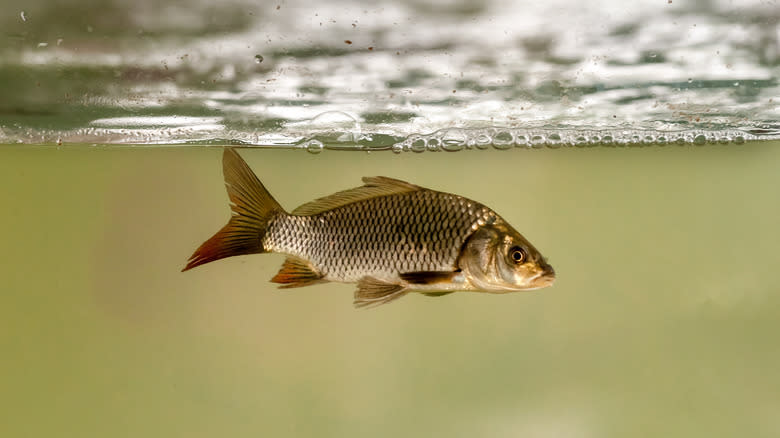
The tilapia boom led to a huge demand for this fish, and while there are some tilapia farms in the United States, the vast majority of it is imported. This can mean that the sources it comes from are not necessarily bound to the same regulations that U.S. fish farms are and that they could be practicing unsustainable methods -- your purchase could have a negative impact.
Therefore, make sure you're choosing your tilapia as wisely as possible. Tilapia sourced from China is the worst option, as there isn't enough clarity around the impacts that these farms have on the environment, and rules may not be as carefully followed or enforced. The Chinese tilapia industry may not also enforce the boundaries of its farms rigorously, leading to fish escaping and ruining nearby habitats. These farms may also use banned antibiotics in the rearing of their fish.
The best sustainable choices are tilapia from Peru or Ecuador, which are raised with environmental impact in mind. Other countries, like Indonesia, Taiwan, Columbia, Honduras, and Mexico also all follow good environmental practices. If in doubt, look for a BAP Certified or Aquaculture Stewardship Council branding on a product, which will usually indicate that it's been reared sustainably. If you can't find any information about where your tilapia has come from, it's likely that it's come from a somewhat dubious source.
Prepping Your Tilapia Wrong
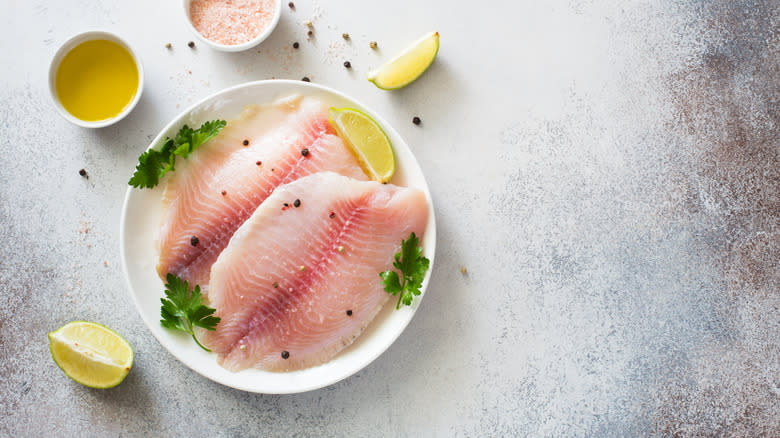
If you're buying your tilapia whole, you'll have a fair amount of preparation to do before it's ready to eat. One of the main mistakes you can make is preparing it wrong, leaving you at risk of ingesting bones, swallowing scales, or inadvertently eating some fish guts.
It's usually easier to get your tilapia gutted at the store. But if this hasn't happened, you'll need to make an incision along the entirety of its belly and remove all of its interior organs, roe, and gills. The same goes for scaling a tilapia -- if the store hasn't done this, use the back of a large knife and run it down the length of the fish's body, shearing off the scales. After scaling and gutting the fish, you should rinse it, both outside and inside.
At this point, you can cook the tilapia whole, but you can divide it up further by filleting it. Start by removing the head with a filleting knife, making a diagonal cut behind the gills. Next, slice lengthwise along the fish's back to produce two fillets. Begin by removing one fillet, slicing along one side of the dorsal fin, and then repeat the process for the other fillet. Use tweezers to eliminate any remaining bones, and if preferred, remove the skin. Finally, season or marinate the fillets according to your preference before cooking.
Forgetting To Pat It Dry
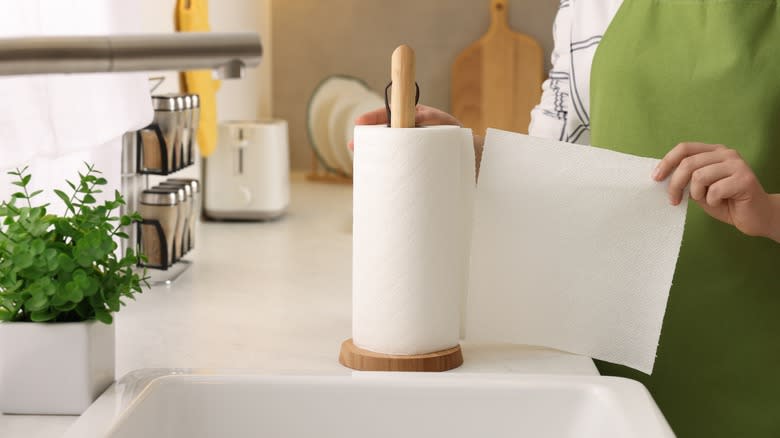
Whether you're using fresh or frozen tilapia, moisture can be an issue. Moisture from packaging or from melted ice crystals can make the texture of your fish watery, and unless you remove this water, it can create steam when cooked. This steam can end up making your fish mushy and soft, instead of keeping it firm and juicy. It can also stop the surface of the tilapia from browning if you're frying or grilling it.
The solution, though, lies in a few squares of paper towel. Use the towel to pat the surface of your tilapia dry before you cook it, absorbing any excess moisture. Make sure to do this before you season the fish, or add any oil to its surface, so you don't just end up dabbing off any flavor you're trying to impart. Ensure, too, that you're pressing down with light pressure when patting it, but not too hard. Try not to rub using the paper towel, as this can cause the fish flesh to start flaking, and may also result in the towel ripping, leaving bits of paper all over the surface of your tilapia.
Storing Your Tilapia Incorrectly
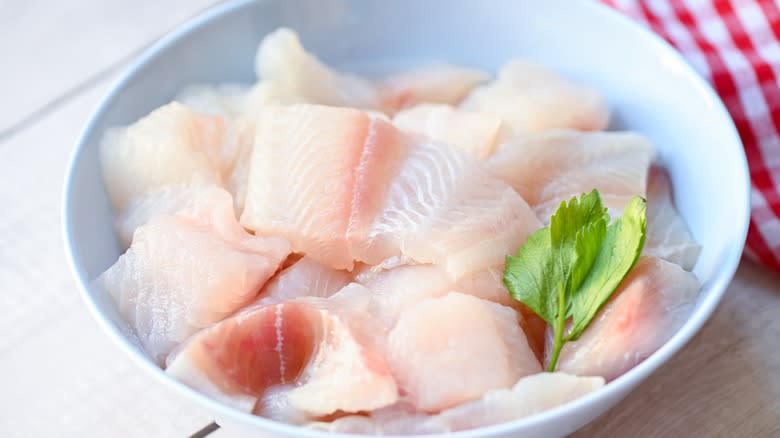
The last thing you want is to go through all of the trouble of picking the best tilapia fillets, getting them home -- and then finding that they're unusable because of the way that you've handled them. Unfortunately, this can happen more often than you think. Incorrectly stored tilapia can lead to cross-contamination with other foods, or deterioration or spoilage of the fish itself, and in the worst-case scenario can lead to food poisoning and illness.
Your storage prep starts the moment you get your fish home from the store. "You should remove your purchased fish from the wrapping or container. Using paper towels, dry all of the surfaces of the fish well and transfer to a clean plastic or reusable closeable bag," says the culinary content manager for Sur La Table, Meredith Abbott in Southern Living. Once this is done, place your tilapia at the bottom of your refrigerator, so that there's no risk of it dripping onto other foods. It's vital that you keep your tilapia as cold as possible, at a temperature of 40 degrees Fahrenheit or below in your fridge. If you're not going to consume your tilapia within 48 hours, freeze it instead. Remember that your tilapia should always be refrigerated or frozen within two hours of purchasing it, and it should always be cold upon point of purchase, too.
Undercooking Or Overcooking Your Tilapia
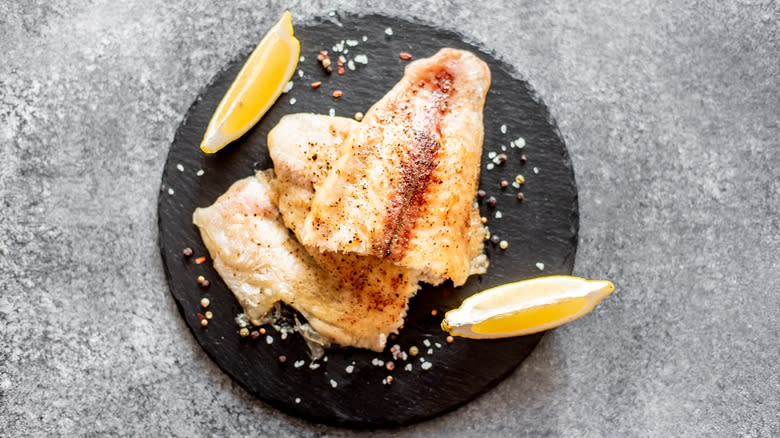
Tilapia, like all fish, can be tricky to cook right. Overcooking it can lead to its flavor and texture being completely ruined. When you overcook fish, it dries out and its proteins bind up tightly, making it dry and overly chewy or gritty. This loss of moisture also means that it can lose its flavor. Undercooking tilapia, on the other hand, can leave it uneven and unappetizing, with none of the flakiness that makes cooked fish so tasty -- it can also increase the risk that you haven't killed off any foodborne illnesses by reaching the right internal temperature.
Instead, you want to aim for the middle ground and perfect doneness. One of the best ways to do this is with a skewer, which will allow you to check the tilapia's interior without having to cut it open. Insert a wooden skewer into the thickest section of the fish, and if it moves through easily, it should be cooked through. Another telltale sign is if your fish is flaking easily, and the sides of your fillets are totally white, assuming, of course, that you haven't seared them on each side, with no pinkish flesh anywhere. Keep to the cooking time instructed for your fish, but don't be tempted to give it considerable extra time because fish cooks fast.
Thawing It Improperly
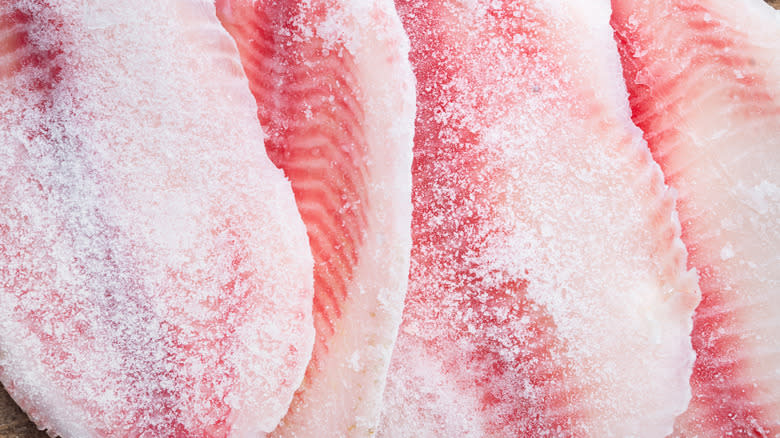
When stored properly frozen tilapia fillets can last for up to eight months in the freezer without deterioration, making them a convenient choice when you have no fresh seafood in the house. But thawing tilapia fillets can be surprisingly tricky. Leaving them at room temperature to thaw may increase the risk of bacterial growth as the flesh becomes warmer. And defrosting them in water may cause them to absorb excess moisture, which can make them challenging to cook.
The best way to defrost fillets is to either leave them in the fridge overnight, which allows for a slow, controlled thawing of the flesh, or to submerge them in cold water in their original packaging. Many frozen fillets will be separately vacuum-packed, and the plastic will act as a barrier between the fish and the water, stopping them from getting too soggy. As fish flesh is pretty delicate, it will defrost quite quickly. Crucially, too, you should never be tempted to use hot water in an attempt to speed the process up. Fish can start to cook at as low as 104 degrees Fahrenheit, and if you're not careful, you'll end up with a fillet that's partially cooked before it even hits the pan.
Seasoning Your Tilapia Poorly
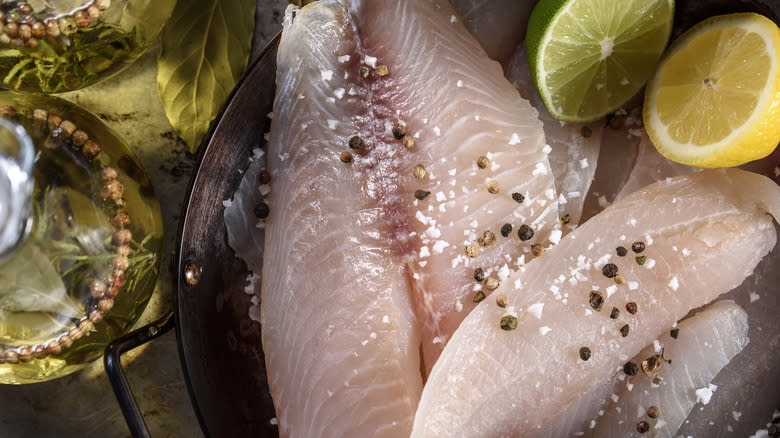
Tilapia's mild flavor lends it to a host of different seasonings, and it's equally at home with the flavors of French cuisine as it is in a curry or a stir-fry. But learning how to season tilapia is crucial to your success. The first thing to remember is to leave your seasoning until you're almost ready to cook. Adding any salty seasonings to tilapia pulls the moisture out of its flesh, making it drier. Acidic seasonings like lemon juice, meanwhile, will start to cook the fish if you add them too soon in advance which is, incidentally, how ceviche is made.
You should also try to avoid any seasonings with an especially overpowering flavor, like copious amounts of pepper, too much ground cumin, or too many cloves. Seasoning is all about lifting the natural flavors of a dish and throwing in too much leaves you at risk of not tasting the fish at all. If you're serving your tilapia as the centerpiece of your meal, ensure that your seasonings are good-quality, with newly-bought spices and soft flaky kosher salt. If your tilapia is going into a stew or being served with a sauce, make sure to add slightly less seasoning than you think at first, and add more after you've done a taste test.
Using The Wrong Pan
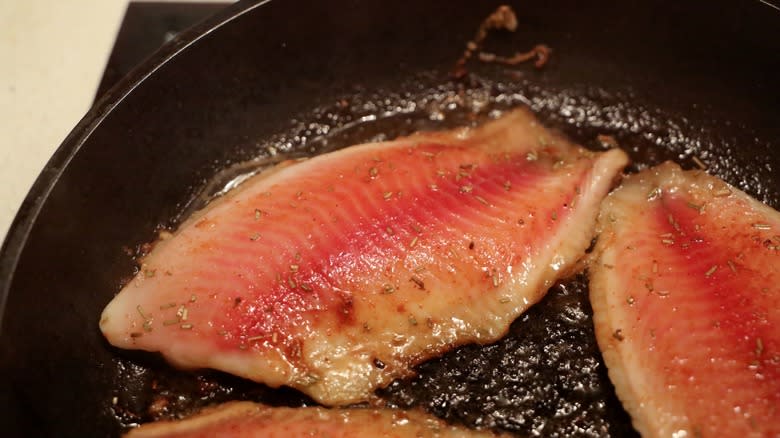
There are many ways to cook tilapia and many different pans in the world. So which ones are best for each cooking style? Generally, if you're frying or sautéing tilapia fillets on the stove, you can't go wrong with a good-quality nonstick pan. Tilapia flesh is pretty delicate and runs the risk of falling apart if it gets stuck to the surface of a pan, but nonstick pans keep the fish able to move freely and help to develop a crispy surface. Woks will also work well for this purpose, whether it's made with a nonstick surface or the wok has been seasoned.
While you can use cast-iron or carbon steel pans, it's important to remember that they can cause food to stick unless they've been seasoned properly, and carbon steel in particular is pretty reactive to acid. If using these types of pans, you should also make sure you're using plenty of oil, to create a barrier between the fish and the pan. Seasoned grill pans are also a great stovetop choice, to develop those appealing chargrilled lines across its surface. If you're cooking your tilapia in the oven, a lightly oil-coated nonstick baking sheet is a good choice, or you can line a regular baking sheet with parchment paper.
Cooking The Wrong Side First
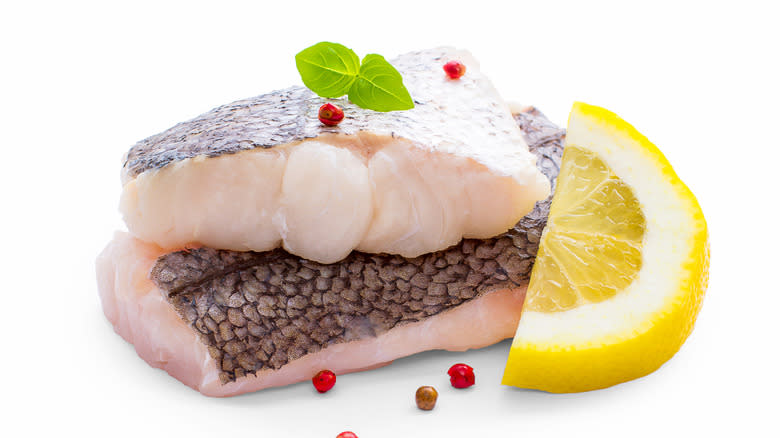
The skin is often the best part of fish, but only if it's been cooked right. When sizzled to perfection, tilapia skin becomes crispy and brittle, acting as the perfect contrast to the soft flesh. If it's cooked incorrectly, however, it becomes limp and slimy, and a part of the fish you'd much rather avoid.
The solution is to cook the right side of the tilapia first -- but remember, which side is best can differ depending on your cooking style. If you're frying your tilapia, or cooking it on a grill, you should always start with the skin side down first. Remember, tilapia cooks quickly, and by starting with the skin side down, it'll start to cook through while simultaneously developing a good crisp. If you start the other way around, however, your tilapia could be overcooked by the time your skin is done.
If you're broiling or baking your tilapia, however, you should flip it and cook it skin side up. This will give the skin the maximum exposure to the dry heat of your oven or broiler, cooking it more effectively. It also means that any fat which is in the tilapia skin will help moisturize the flesh.
Flipping Your Tilapia Too Much
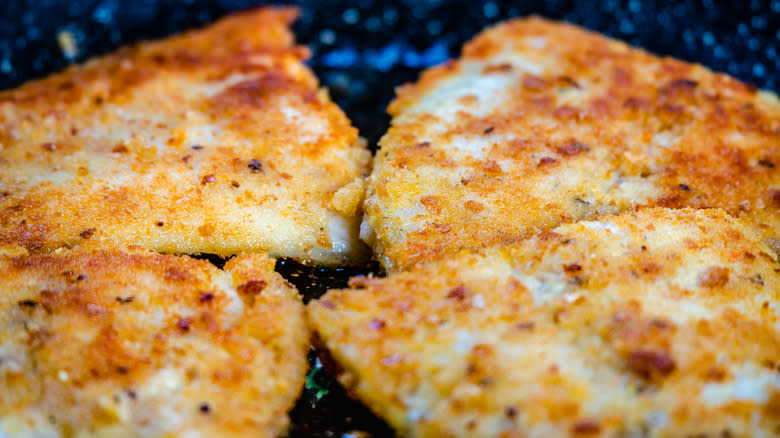
If there's anything that unites humanity, it's the temptation to prod and flip meat while it's cooking. But with tilapia, this should always be resisted. "Fish is very delicate; the more you move it in the pan, the more juice it loses, causing the meat to break," explains chef Roberto Bellitti to Food & Wine. "The less you touch the fish, the better."
Flipping your tilapia needlessly also means that you get in the way of any browning occurring on its surface. For the Maillard reaction that creates so much extra flavor to occur, tilapia needs to be able to cook undisturbed. A good way to tell whether tilapia is ready to flip over is by giving your pan a gentle wiggle. If the fish is still stuck to the bottom of the pan, it hasn't yet developed a proper crust on the bottom and needs more time to cook. If it moves easily, however, it means that enough browning has occurred for it to be released, and it's ready to flip. Pan-seared tilapia fillets are generally ready to flip after about 3-4 minutes, although they may take longer if your cuts are especially thick.
Underheating Your Pan
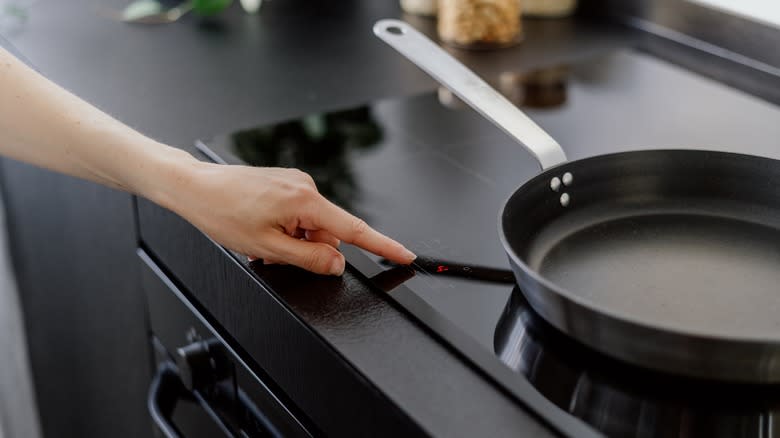
When pan-frying tilapia, it pays to be confident with your heat. "Heating your pan properly is a key factor for keeping your fish from sticking and will give you a flavorful crust," says the Institute of Culinary Education's School of Recreational Cooking director Kate McCue to Martha Stewart. If you don't get your pan up to a high enough temperature, your fish will cook through before it has a chance to get an even brownness on its exterior and runs the risk of steaming instead of searing.
As such, it's best to turn it up and use your eyes. "Heat your pan on a medium-high heat, then add a small amount of oil or clarified butter. When the fat is shimmering, the pan is hot enough to add your protein," states McCue. She recommends keeping an ear out for a good sizzling sound. If that doesn't happen, it's likely that your skillet isn't hot enough, and you'll need to turn it up fast.
It's also vital that you're using tilapia that hasn't come straight out of the fridge, as this will just cause your pan's temperature to drop rapidly. Leave your fillets out of the fridge for at least 30 minutes just before you fry them.
Using The Wrong Sauce With Your Tilapia
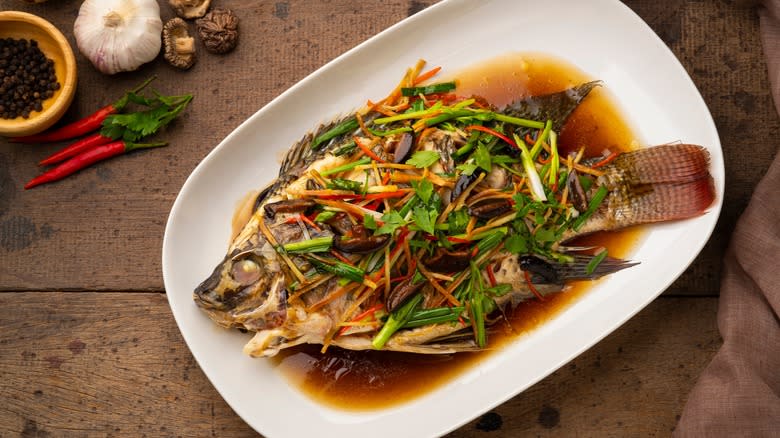
Tilapia may be versatile, but it doesn't go with everything, and there are certain sauces that are best avoided. Dairy is a particular no-no for tilapia, as well as any type of fish. "Cream sauce with fish is just wrong," instructs chef Roberto Bellitti to Food & Wine. Cream, as well as other high-fat dairies, are too dense, and get in the way of the actual flavor of the fish, meaning it gets lost in the sauce and becomes just another protein. The light salinity of the fish's natural taste also clashes with the richness of the dairy fats.
The best thing to opt for, says Bellitti, are bright, zesty sauces that almost work as more of a dressing. "The types of sauces that work best with fish are citrus, so lime, lemon, or orange," he states. The acidity and lightly floral tastes of these fruits underpin the sweet notes in the fish, creating balance throughout your dish. Saltier, soy-based sauces can also work well, but it's important not to add too much, as this will just leave your fish tasting too briny.
Resting Your Tilapia After Cooking It
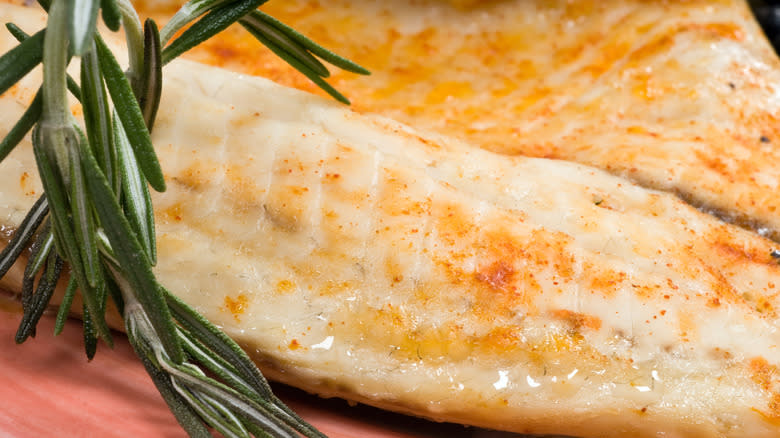
Although it can be tempting to think you need to rest fish like tilapia, it's far better to serve it straight away. Tilapia, like other types of white fish, doesn't have a lot of connective tissue, which is partly why it's so flaky when cooked. Unfortunately, this lack of connective tissue also means that when it's allowed to rest, it begins to separate. The relative lack of density in tilapia can also mean that if it's left to rest, it loses temperature quickly, and by the time you serve it, it's gone cold.
So, it's best to serve it as quickly as possible. If you've cooked it at a super-high heat, you might want to give it a moment or two so you don't end up burning your mouth, but generally speaking, tilapia should be served immediately. Remember, the best way to ensure that tilapia is juicy and moist is not to rest it, but to avoid overcooking it in the first place. Additionally, keep in mind that while you shouldn't rest tilapia, the same can't be said for other types of fish. Fatty fish like salmon or trout benefit from being rested for a few minutes, to allow the fat and other juices to redistribute through their flesh.
Read the original article on Daily Meal.

